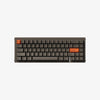メカニカルキーボードのスイッチの掃除方法

メカニカルキーボードの重要性の概要
メカニカルキーボードは、耐久性、触感、そして個々のキーに合わせたカスタマイズを求める人にとって魅力的です。一般的なメンブレンキーボードはラバードームでキーストロークを完結しますが、メカニカルキーボードは各キーキャップの下に独立したメカニカルスイッチを備えています。これらのキーは、その応答速度と使用頻度の高さから、ゲーマー、プログラマー、タイピストに愛されています。しかし、最高の状態で動作させるには定期的なクリーニングが必要です。メカニカルキーボードのスイッチのクリーニング方法をお探しですか?この記事では、メカニカルキーボードのスイッチを最高の状態に保つためのクリーニング方法を段階的にご紹介します。
汚れたスイッチが原因となる一般的な問題
メカニカルキーボードのスイッチが汚れていると、キーの固着などの問題が発生することがあります。これにより、ワークフローが中断され、ゲームや長い文書の途中で問題が発生します。埃が付着するとキーの作動が不安定になり、キーの打ち忘れや重複入力が発生することがあります。しかし、スイッチのクリーニングを怠ると、キーボードの寿命が縮まり、長期的には本来の性能を発揮できなくなります。
事前洗浄:準備手順
必要な道具と材料
推奨される清掃用品のリスト
メカニカルキーボードのスイッチを効果的に掃除するには、適切な掃除用品が不可欠です。推奨されるアイテムは最高の状態を保証します。
- イソプロピルアルコール(70%以上)キーボードのスイッチに損傷の痕跡を残さずに、ほこり、汚れ、汚れを除去するのに最適です。
- マイクロファイバークロス:掃除後の拭き掃除やキーボードのスイッチ類の掃除に最適で、ピカピカの状態に仕上がります。
- 圧縮空気ダスター:特に複雑なデザインが施されていることが多いキーボードから詰まった粒子を取り除くのに非常に効果的です。
- キーボードキーキャッププーラー:監視プロセスを容易にするために、スイッチを操作する際にキーキャップを安全に取り外すための必須の器具が利用できることが重要です。
- 小型クリーニングブラシ:スイッチの徹底的な洗浄や届きにくい箇所の洗浄に便利です。
プロ用ツールのDIY代替品

専用のキーボードクリーニングツールがない場合は、同様の結果を得るために使用できる DIY の代替手段があります。
- DIYキーキャッププーラー:ペーパークリップやプラスチックカードを使ってキーキャッププーラーを作ることもできます。U字型に曲げたり、カードを平らにして下に差し込んだりすれば、キーを簡単に外すことができます。
- 自家製洗浄液:スイッチとキーキャップを食器用洗剤とぬるま湯で優しく洗い、優しく洗浄してください。組み立てる前に、部品が完全に乾いていることを確認してください。
- 綿棒またはつまようじ:これらは、スイッチの周りを丁寧に掃除し、こびりついた汚れを取り除くのに役立ちます。
- ソフトブリッスルブラシ:小さな掃除用ブラシがない場合は、表面を傷つけずにスイッチを掃除するには、先端が柔らかい歯ブラシを使うのがよいでしょう。
推奨されるクリーニング用品と自家製のバリエーションを使用すると、メカニカルキーボードのスイッチをきれいにクリーニングできるため、適切な機能と耐久性が保証されます。
安全のヒント
電気安全に関する注意事項
メカニカルキーボードのスイッチを安全に清掃するには、キーボードを電源から外してください。そうしないと、ショートや感電の危険があります。電気的な干渉を避けるため、キーボードを取り外してください。強力な電子部品の近くでは、液体の取り扱いに十分注意してください。液体がこぼれると、修復不可能な問題が発生する可能性があります。推奨される洗浄剤には、細菌を除去するか、スイッチを拭くためのイソブチルゴムまたは70%以上の濃度のアルコールを使用してください。
キーボードの損傷を防ぐためのヒント
機械式スイッチボードのクリーニングは、キーキャップを取り外し、スイッチを持ち上げて取り外します。損傷を防ぐため、過度の力や鋭利なものは使用しないでください。柔らかい毛のブラシまたは圧縮空気を使用して、余分なほこりやゴミを取り除きます。それでも落ちない汚れがある場合は、綿棒または布にイソプロピルアルコールを含ませ、その部分を拭き取ります。スイッチを完全に自然乾燥させ、キーキャップを元の位置に戻してから、キーボードを電源付きデバイスに接続してください。
クリーニング手順:ステップバイステップガイド
外部洗浄
キーキャップのクリーニング
メカニカルキースイッチを清掃するには、キーキャップ引き抜き工具を使ってキーキャップを慎重に取り外し、15~20分間お湯に浸します。その後、柔らかいブラシを使って優しくこすり、届きにくい場所や隅まで清掃します。キーをきれいな水で優しく拭き、完全に自然乾燥させてからキーボードに戻します。
キーボード表面のほこりを取るテクニック
圧縮空気を使って、スイッチ周りの埃や汚れを取り除きます。埃が落ちていること、そしてキーボードが傾いていることを確認してください。頑固な汚れには、マイクロファイバークロスを水とイソプロピルアルコールで湿らせ、スイッチ周りに注意しながらキーボードをこすります。多量の水分や強力な洗剤を使う必要はありません。
内部清掃
キーボードを開く
必要なツール
メカニカルキーボードのスイッチをクリーニングのために取り外すには、キーキャッププーラー、プラスドライバー、そしてクレジットカードやプラスチック製のスパッジャーなどの平らな工具を使用します。これらの工具を使えば、キーキャップを簡単に取り外し、スイッチを損傷することなくキーボードの筐体を開けることができます。
ステップバイステップの分解
キーボードを掃除するには、まずコンピューターからプラグを抜き、各キーキャップを慎重に取り外します。ドライバーを使ってキーボードケースを固定しているネジを外し、平らな工具を使ってケースを慎重にこじ開けます。締めすぎるとプラスチックが割れたり、内部の部品が損傷したりする可能性があるため、注意してください。ケースを開けてメカニカルスイッチを掃除します。ネジは紛失しないように注意してください。後でキーボードを組み立てる際に必要になります。
スイッチのクリーニング

ドライクリーニング方法(圧縮空気、柔らかいブラシ)
定期的な清掃や軽い汚れの場合は、メカニカルキーボードのスイッチを乾式洗浄してください。圧縮空気は、スイッチ間の埃、パンくず、粒子を除去するツールとして人気が高まっています。電気系統のトラブルを防ぐため、圧縮空気を使用する前に必ずキーボードの電源プラグを抜いてください。絵筆やメイクブラシなどの柔らかい毛先を使うと、接点を傷つけることなく表面の汚れを素早く取り除くことができます。
湿式洗浄法(イソプロピルアルコール、特殊溶液)
キーボードのスイッチは洗えますか?メカニカルキーボードのスイッチのクリーニングには、イソプロピルアルコールなどのウェットクリーニング法や専用の洗浄液の使用をお勧めします。一方、綿棒や布にイソプロピルアルコールを塗布すると、乾燥して液体の拡散を防ぎ、損傷を防ぎます。専用の洗浄液を使用することで、スイッチの性能に影響を与えることなく、しっかりと洗浄できます。スイッチを水に浸したり、水没させたりすることは、スイッチや電子部品に損傷を与える可能性があるため、避けてください。問題が発生する可能性を排除するため、キーボードをコンピューターに接続する前に、完全に乾いていることを確認してください。
粘着性や反応しないスイッチの徹底洗浄
スイッチの分解
メカニカルキーボードのスイッチが固くなっている場合の掃除方法を学ぶには、まずキーキャップを外し、個々のスイッチに手を伸ばして分解することから始めましょう。スイッチプーラーまたはマイナスドライバーを用意し、ソケットに優しく当てて、無理な力を加えずに緩めます。スイッチがプレートに取り付けられている場合は、キーボードのデザインに合わせてネジを外します。
内部スイッチ部品の詳細なクリーニング
ワイヤーを取り外すことで、内部部品の清掃に集中できるようになります。スイッチケースを清掃する際は、圧縮空気やブラシを使って埃を吹き飛ばします。スイッチがベタベタしている場合は、綿棒にイソプロピルアルコールを含ませ、接点とその周辺を拭きます。スイッチを組み立てる前に、アルコールが完全に蒸発していることを確認してください。スイッチが汚れていたり、ベタベタしている場合は、イソプロピルアルコールに3~5分ほど浸した後、細いブラシで優しくこすります。スイッチが完全に乾いたら、しばらく置いてから、キーキャップを取り付けるキーボードに戻します。
キーボードの再組み立て
キーボードを安全に組み立て直す手順
- スイッチの配置:きれいなスイッチを PCB マトリックス上の指定された場所に正しく取り付け、位置が合っていることを確認します。
- スイッチの保護:各スイッチを軽く押して、しっかりと固定され、ゲーム使用中に緩まないことを確認します。
- キーボードカバーの取り付け:すべてのスイッチが所定の位置に配置されたら、キーボード カバーを元に戻し、すべてのタブとネジが取り付けられてしっかりと固定されていることを確認します。
すべてのコンポーネントが適切に配置されていることを確認する
組み立て直す際は、キーの誤作動やキーの押し間違いを防ぐため、すべての部品が適切に直角に取り付けられていることを確認してください。すべてのスイッチが正しい位置にあること、そしてキーボードがスイッチをしっかりと覆っていることを確認してください。キーボードの入力調整、タイプライター機能、そして問題のあるボタンを確認してください。これは、クリーニング後にキーボードのメカニカルスイッチを修復するプロセスであり、より高いパフォーマンスとより長い動作を保証するのに役立ちます。
清潔さを長持ちさせるためのメンテナンスのヒント
定期清掃スケジュール
メカニカルキーボードのスイッチを清潔に保つことは、良好なパフォーマンスと寿命を最大限に延ばすために非常に重要です。定期的なクリーニングは、キーボードのスイッチを埃やゴミ、指紋のない状態に保つ鍵です。キーボードのスイッチは、少なくとも数ヶ月に一度は、あるいはキーが正常に動作しない、あるいは反応が不十分な場合はそれ以上、できるだけ頻繁にクリーニングしてください。
日常メンテナンスのベストプラクティス
メカニカルキーボードのスイッチをメンテナンスするには、以下の日常的なメンテナンス習慣を実践してください。圧縮空気を使って埃を取り除き、キーキャッププーラーを使って特殊なクリーニングを行い、スイッチが固い場合はイソプロピルアルコールと水を混ぜた優しい溶液でスイッチを拭き取ってください。これらの習慣を実践することで、スイッチの寿命が長くなり、機能性も維持されます。これらの習慣を実践することで、メカニカルスイッチは新品同様の状態を保つことができます。
クリーニング後の一般的な問題のトラブルシューティング
キーが登録されない
クリーニング後もキーがいくつか動作しない場合は、スイッチの接続部を確認し、PCBまたはプレートに正しく取り付けられていることを確認してください。キャップキーがスイッチに正しく配置され、押し込まれていることを確認してください。それでも問題が解決しない場合は、PCBに実装されたスイッチの接続部に損傷や接続不良がないか確認してください。
キーの固着やスイッチの異常な音
クリーニング作業の最後にキーのベタつきや異音に気づいた場合は、詰まったプラグを洗浄して乾燥させてください。キーキャップのステムに埃やゴミが付着していないか点検し、メーカーのガイドラインに従ってスイッチに潤滑剤を塗布することをお勧めします。ただし、過剰な潤滑はスイッチの応答性の低下につながるため、避けてください。
高度なヒントとコツ
スイッチの潤滑によるパフォーマンス向上
スイッチに潤滑剤を塗布すると、適切なフィードバックが得られ、摩擦が最小限に抑えられ、タイピングやゲーム体験が向上します。油分が少なくサラサラとした高品質のスイッチ潤滑剤を、スイッチハウジングとステムに塗布してください。オイルを塗りすぎると、スイッチがぐにゃぐにゃした感じになってしまうので注意してください。
スイッチの改造
スイッチの改造とは、スイッチをカスタマイズして特定の質感や音色を実現することを指します。バネをスナップに交換したり、スイッチのハウジングやステムを交換したりすることもあります。改造には、キーボードの部品の取り外しと交換方法を理解するだけでなく、保証が無効になるなどのリスクも伴うため、キーボードを改造する前には慎重に検討する必要があります。
概要
主なポイントの要約
メカニカルキーボードのスイッチは、その性能と寿命を維持するために、定期的にクリーニングする必要があります。クリーニングは、キーキャップを外し、スイッチを丁寧に洗浄することで、キーのベタつきや反応不良を防ぎ、快適なタイピング体験を実現します。定期的なクリーニングは、埃の煩わしさから解放され、快適なタイピング体験を維持するだけでなく、経年劣化による機械的な問題の発生を防ぐことにもつながります。
定期的な清掃の重要性
メカニカルキーボードのスイッチを定期的に洗浄することは、キーの滑りを良くし、固着を防ぐ上で重要です。キーキャッププーラーまたは指を使ってキーキャップを外し、エアダスターで緩んだ汚れを取り除き、イソプロピルアルコールに浸した綿棒で頑固な汚れを落とします。完全に自然乾燥させた後、スイッチを元に戻します。キーボードを長時間使用しても滑らかで快適なタイピング感を維持したい場合は、この洗浄手順を必ず実行してください。
よくある質問
- メカニカルキーボードのスイッチはどのくらいの頻度で掃除すればよいですか?
最高のパフォーマンスを得るには、メカニカル キーボード スイッチを 3 ~ 6 か月ごとにクリーニングすることをお勧めします。
- スイッチを損傷せずにキーボードを掃除する最も安全な方法は何ですか?
キーボードを掃除する最も安全な方法は、圧縮空気を使って埃や汚れを取り除くことです。デバイスのスイッチに液体を吹きかけないでください。
- メカニカルスイッチを水で洗浄できますか?
いいえ、水はスイッチを損傷する可能性があります。代わりに、イソプロピルアルコールと綿棒を使用して清掃してください。
- スイッチを掃除する必要があることを示す兆候は何ですか?
兆候としては、押したときに正しくバインドされない、入力したときに文字が正しく処理されない、キーキャップの下に目に見える汚れや粒子があることなどが挙げられます。
- 古いキーボードスイッチを掃除する価値はあるでしょうか、それとも交換したほうがよいでしょうか?
古いスイッチがまだ良好な状態であれば、クリーニングは必須です。しかし、摩耗したりひどく損傷したりした場合は、新しいスイッチに交換するのが最善の解決策です。





























